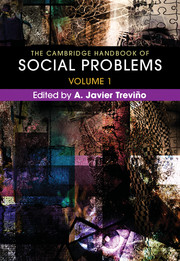Book contents
- The Cambridge Handbook of Social Problems
- The Cambridge Handbook of Social Problems
- Copyright page
- Contents
- About the Contributors
- Introduction
- Part I General Concerns and Orientations in the Study of Social Problems
- Part II Historical and Theoretical Issues in the Study of Social Problems
- Part III Problems of Discrimination and Inequality
- Chapter 17 Racism
- Chapter 18 Immigration
- Chapter 19 Gender Inequality
- Chapter 20 Sexualities and Homophobia
- Chapter 21 Poverty and Income Inequality: A Cross-National Perspective on Social Citizenship
- Chapter 22 Housing Market Discrimination
- Chapter 23 Hunger and Food Insecurity
- Chapter 24 Ageism, Past and Present
- Chapter 25 Disabilities
- Part IV Problems of Institutions
- Index
- References
Chapter 21 - Poverty and Income Inequality: A Cross-National Perspective on Social Citizenship
from Part III - Problems of Discrimination and Inequality
Published online by Cambridge University Press: 16 March 2018
- The Cambridge Handbook of Social Problems
- The Cambridge Handbook of Social Problems
- Copyright page
- Contents
- About the Contributors
- Introduction
- Part I General Concerns and Orientations in the Study of Social Problems
- Part II Historical and Theoretical Issues in the Study of Social Problems
- Part III Problems of Discrimination and Inequality
- Chapter 17 Racism
- Chapter 18 Immigration
- Chapter 19 Gender Inequality
- Chapter 20 Sexualities and Homophobia
- Chapter 21 Poverty and Income Inequality: A Cross-National Perspective on Social Citizenship
- Chapter 22 Housing Market Discrimination
- Chapter 23 Hunger and Food Insecurity
- Chapter 24 Ageism, Past and Present
- Chapter 25 Disabilities
- Part IV Problems of Institutions
- Index
- References
Summary
Global-scale economic crisis has brought renewed attention to issues of poverty and inequality, yet we often fail to critically examine what we mean by inequality. Poverty and inequality are social constructions; therefore, how they are defined has important implications for how societies understand and address inequality. This chapter provides an overview on measures and concepts used to study poverty and income inequality from a comparative perspective. We discuss the issue of poverty and consider how the social citizenship framework of T. H. Marshall opens new ways of understanding inequality. Increasing inequality has created a new class of poor, who are not only materially deprived but are also deprived of political and cultural life, unable to participate fully as members of a society, or are “socially excluded.” We argue that clarifying what we mean by social rights allows us to more concretely discuss the concepts of needs, equality, and social inclusion.
- Type
- Chapter
- Information
- The Cambridge Handbook of Social Problems , pp. 385 - 408Publisher: Cambridge University PressPrint publication year: 2018



